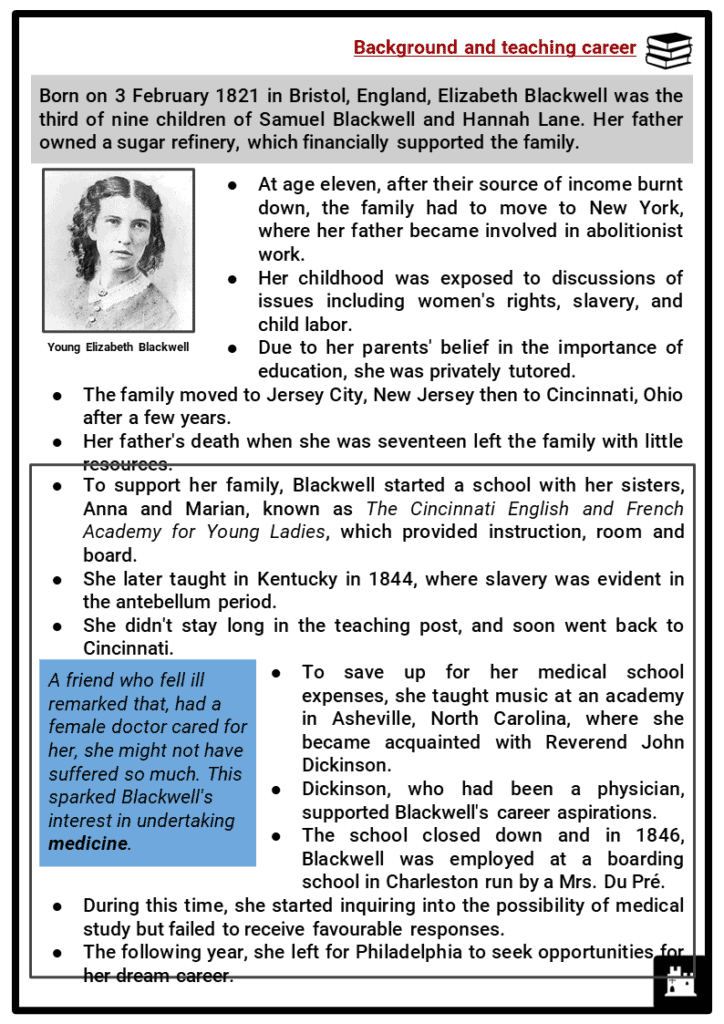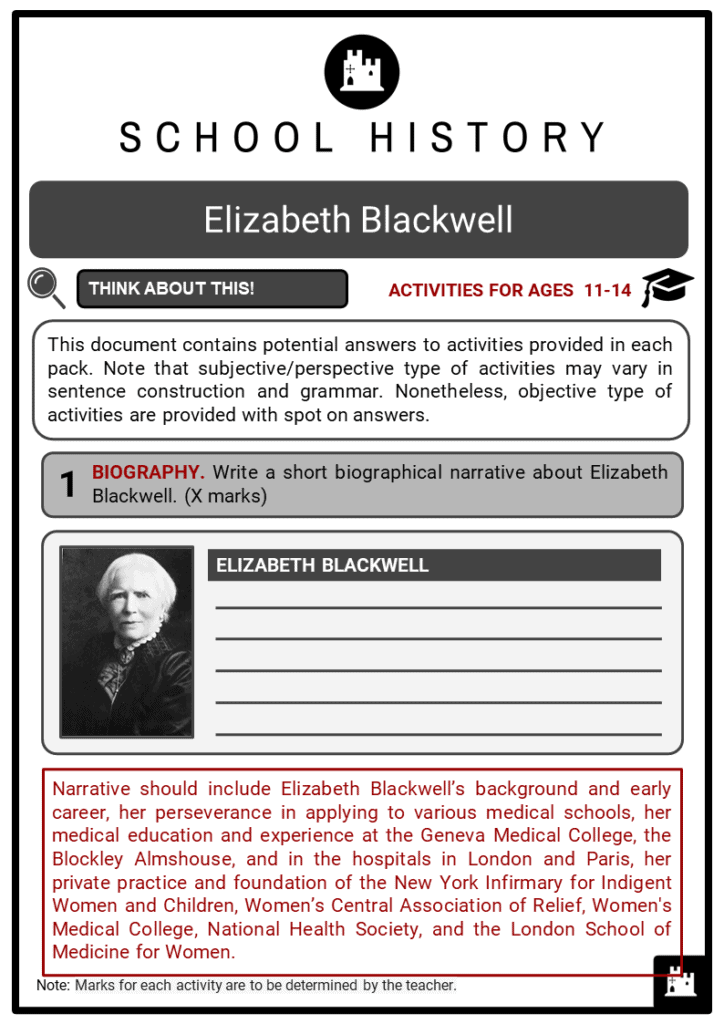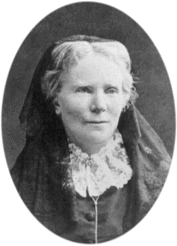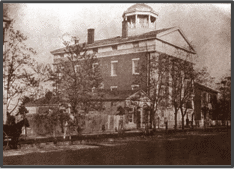Download Elizabeth Blackwell Worksheets
Do you want to save dozens of hours in time? Get your evenings and weekends back? Be able to teach Elizabeth Blackwell to your students?
Our worksheet bundle includes a fact file and printable worksheets and student activities. Perfect for both the classroom and homeschooling!
Table of Contents
Add a header to begin generating the table of contents
Summary
- Background and teaching career
- Medical education
- Medical career
Key Facts And Information
Let’s find out more about Elizabeth Blackwell!
- Elizabeth Blackwell was a pioneer in promoting education for women in medicine. She was recognised as the first woman to receive a medical degree in the United States in 1849, and the first woman on the Medical Register of the General Medical Council in the United Kingdom in 1859.
- She founded the ‘New York Infirmary for Women and Children’ and ‘Women's Medical College’ with her sister, and was heavily involved in the establishment of the National Health Society and the London School of Medicine for Women. During the American Civil War, she played an important role in upholding nursing efforts with the creation of the Women’s Central Association of Relief.
Background and teaching career
- Born on 3 February 1821 in Bristol, England, Elizabeth Blackwell was the third of nine children of Samuel Blackwell and Hannah Lane. Her father owned a sugar refinery, which financially supported the family.
- At age eleven, after their source of income burnt down, the family had to move to New York, where her father became involved in abolitionist work.
- Her childhood was exposed to discussions of issues including women's rights, slavery, and child labor.
- Due to her parents' belief in the importance of education, she was privately tutored.
- The family moved to Jersey City, New Jersey then to Cincinnati, Ohio after a few years.
- Her father's death when she was seventeen left the family with little resources.
- To support her family, Blackwell started a school with her sisters, Anna and Marian, known as The Cincinnati English and French Academy for Young Ladies, which provided instruction, room and board.
- She later taught in Kentucky in 1844, where slavery was evident in the antebellum period.
- She didn't stay long in the teaching post, and soon went back to Cincinnati.
- To save up for her medical school expenses, she taught music at an academy in Asheville, North Carolina, where she became acquainted with Reverend John Dickinson.
- Dickinson, who had been a physician, supported Blackwell's career aspirations.
- The school closed down and in 1846, Blackwell was employed at a boarding school in Charleston run by a Mrs. Du Pré.
- During this time, she started inquiring into the possibility of medical study but failed to receive favourable responses.
- The following year, she left for Philadelphia to seek opportunities for her dream career.
- In Philadelphia, she initially studied anatomy privately with other sympathetic physicians, whilst trying to enter in any medical school in the area.
- However, she was rejected in all medical schools she applied for, and was even advised to go to Paris, where her chance was higher.
- Why was Blackwell rejected?
- She was a woman and was considered intellectually inferior. Women used to be excluded from the male-dominated study of medicine.
- She might prove equal to the task and she could not expect the school to ‘furnish [her] with a stick to break our heads with’.
Medical education
- Whilst she faced many rejections, Blackwell persevered and was accepted at Geneva Medical College, New York in October 1847. Her admission was decided upon by the all-male student body, who unanimously voted in her favour as a joke.
- Blackwell had a hard time adapting but felt at home at Geneva.
- She chose to isolate herself and persisted through mistreatment by students, staff, and patients.
- She returned to Philadelphia between her two terms at Geneva and applied for a medical position in the area.
- She was accepted by ‘The Guardians of the Poor’, the city commission that ran Blockley Almshouse.
- She successfully gained valuable clinical experience, despite the lack of support she encountered there.
- Blackwell graduated from Geneva on 23 January 1849, becoming the first woman to complete a medical degree in the United States.
- To further her medical studies, Blackwell traveled to Europe, where she visited hospitals in London and Paris.
- She focused on the care of women and children, enrolling at La Maternité, where she was treated as a student midwife.
- An incident on 4 November 1849 resulted in her losing sight of her left eye. This prevented her from becoming a surgeon.
- In 1850, she enrolled at St. Bartholomew's Hospital in London and made a positive impression there.
- In 1851, she traveled back to New York City to establish her own practice.
Medical career
- Back in the United States, Blackwell's private practice earned little support and received very few patients. In 1852, she started giving lectures and completed her first work, ‘The Laws of Life with Special Reference to the Physical Education of Girls’.
- In 1853, she opened a small dispensary near Tompkins Square and took Marie Zakrzewska, a medical student, under her wing.
- In 1857, the dispensary expanded into the New York Infirmary for Indigent Women and Children, with the help of Zakrzewska and her sister Emily, both of whom had obtained a medical degree.
- The institution provided female doctors and medical students a safe and fair environment to practice their profession.
- It provided poor women and children with quality medical care and served as a nurse's training facility.
- With the outbreak of the American Civil War in 1861, Blackwell and her sisters organised the Women’s Central Association of Relief (WCAR) to aid in nursing efforts.
- Though they met resistance, WCAR was eventually absorbed by the United States Sanitary Commission (USSC), a private agency that supervised all efforts to support wounded and sick soldiers.
- Goals of the WCAR:
- Organise women’s charity efforts and promote the creation of more
- Establish a working relationship with the US military
- Select and train women as professional nurses who could be hired to work in military hospitals
- Due to her abolitionist roots, Blackwell sympathized with the North and supported the Union effort.
- She saw the war as opportunity for women to rise above and to assert themselves as respectable medical professionals.
- Her vision of professionalizing women's work was sidelined as Dorothea Dix, a medical activist who believed that nurses should be volunteers instead of paid professionals, was appointed as Superintendent of Women Nurses by the USSC.
- This did not stop Blackwell and the WCAR to provide relief at the war front.
- With the goal to establish a parallel infirmary project, Blackwell made several visits to Britain.
- She became the first woman on the General Medical Council's medical register in January 1859 in Britain, under a clause of the Medical Act of 1858.
- In 1866, as patients at the New York Infirmary increased, she had to return to the US and abandon her infirmary project plans abroad.
- In 1867, she established the Women's Medical College at the New York Infirmary.
- The establishment of the school was groundbreaking as it provided women with a comprehensive medical education without encountering constant prejudice and resistance.
- Power struggle over the management of the infirmary and the school caused a rift between Blackwell and her sister Emily.
- In 1869, Blackwell moved to Britain, where she became active in social reform and authorship.
- In 1871, she co-founded the National Health Society in London.
- She traveled extensively across Europe and maintained her wealthy status.
- She opened the first medical school for women in England, the London School of Medicine for Women, with Sophia Jex-Blake in 1874.
- She lost much of her authority to Jex-Blake and became a lecturer in midwifery.
- She retired from medicine completely in 1877 but continued to advocate for reform, switching back and forth between various reform organisations.
- Blackwell remained relatively active in her later years until an accident while on a holiday in Scotland in 1907 left her almost completely mentally and physically disabled.
- She died on 31 May 1910 at her home in Hastings, Sussex and was buried in the graveyard of St Munn's Parish Church, Kilmun.
Image sources:








